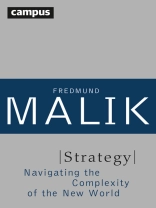This book describes Malik's strategic solutions for the Revolutions of the New World, which are already underway. They are part of the Great Transformation 21 which the author will address in the book.
In the six parts of this book, he will first look at the dynamics of the Great Transformation 21, its inherent risks of crisis and its opportunities, as well as the labor pains that the New World is suffering. After that, he will deal with the amazingly effective cybernetic systems for strategic navigation and the strategy maps required for that, as well as the empirical quantification of businesses, both existing and yet unknown, which will help break the new territory of innovation. Finally, Malik will reveal the patterns that the tidal currents of great transformations invariably follow, as well as the economic dynamics resulting from them and the strategies required to deal with them.
In the last part of the book he will describe the revolutionary new methods that enable us to master groundbreaking strategic change with great precision and unprecedented time compression – at the ’speed of light‘, so to speak. This way, even enormous corporate growth and size can be managed and turned into true strengths, with perfect ease and using innovative approaches where conventional approaches have proven useless.
Inhaltsverzeichnis
Contents
Preface 19
Strategic Solutions for REvolutions 19
The New Challenges 19
The Right Knowledge 21
The Right Strategy for the Great Transformation21 23
The Revolution in the Great Transformation21 24
Innovative, Intelligent and Right Solutions 25
Strategy: Navigating Effectively Through the Complexity of the Great Transformation21 26
Key Propositions 28
A Word On the Terms Used 30
Part I: Strategy for the Great Transformation21
1.What Strategy Looks Like When the Future is Unknown 37
2.The Great Transformation21 41
The Old World Ends as a New World Is Born 43
Megachange in Megasystems 44
The Current Crisis as the New World's Birth Pangs 45
It Takes More than Economics to Understand the Global Economic Crisis 46
Anglo-Saxon Corporate Governance-A Machine of Destruction 47
Complexity and Management Crisis: The Absence of Neuronal Systems 50
Third Act of the Crisis: Deflation 51
The New Way of Functioning: Mastering Complexity 53
3.When You Do Not Know What You Need to Know: The Minefield of Strategic Errors 55
Strategic Delusion by Operational Data 55
Operational and Strategic Management 60
Strategic Thinking Traps 66
Part II: Strategy as Master Control in the Wholistic Management Systems
1.Making Companies Function Well 77
Enhancing Management Impact Through Management Support Systems 77
Right and Good Management-Universally Valid 78
Management, Financial Markets, and Alpinism 81
A Practical Hint for Readers in the Know 82
What are Master Controls? 83
The Basic Management Model and Its Basic Concepts 84
Management of Institutions: The General Management Model 85
Management of People: The Standard Model of Effectiveness, or ‚Management Wheel‘ 88
The Integrated Management System-IMS 89
Integrated Strategy as a Top Cross-Divisional Function 92
2.Providing Direction Through Corporate Policy and Business Mission 95
The Right Purpose 95
The Right Mission 100
The Right Performance 106
Part III: Mastering Complexity Through Reliable Navigation in Any Circumstance
1.Revolutionizing Strategic Navigation 113
The Malik-Gälweiler Navigation System 114
The Right Strategy for a Future Unknown 117
Putting an End to Arbitrariness in Strategy Design 117
Looking Further Into the Future-Without Forecasts 119
Time Constants and System Dead Time 119
Limitations of the Market Economy: Why Economists Do Not See Far Enough 120
What Must Be Monitored: Variables for Control and Orientation 121
Reliable Function With Cybernetic Control Systems 122
2.Reliable Control Through Cybernetic Navigation 124
First System Level: Liquidity 124
Second System Level: Profit 129
Third System Level: Current Profit Potential (CPP) 131
Fourth System Level: Future Profit Potentials (FPPs) 136
3.Setting the Right Strategy, Irrespective of Economic Climate: The Strategy Map 143
The Solution-Invariant Customer Problem 147
Solution Technologies 154
Socioeconomic Trends 157
Market Position 159
Investments and Cost Reduction Potentials 166
Research and Development Objectives 168
Finance and Balance Sheet Variables 170
Part IV: Following the Change: Success Factors for Your Current Business
1.No More Blind Flying: PIMS-The High Art of Strategy Development 175
Strategic Leadership 176
The PIMS Revolution 178
Strategy at the Strategic Business Unit Level 179
Discovery of the ‚Laws of the Market Place‘ 179
A Brilliant Research Idea: Profits Are Driven by Structure, not the Industry 181
New Benchmarking Based on the Biological Pattern 182
The PIMS Database Suites 183
Universally Valid Factors Determine Seventy-five Percent of Profits 185
Answering Key Questions of Strategy 187
Eight Key Factors for Success 188
2.
Über den Autor
Prof. Dr. Fredmund Malik is habilitated Professor of Corporate Governance and an internationally renowned management expert. He is founder and chairman of Malik Management, the world's leading knowledge organization for integrated management systems based on the science of cybernetics. Based in St. Gallen, Malik Management has around 300 employees, offices in six countries, and a network of partner organizations in the fields of cybernetics and bionics. It is the biggest provider of reliably functioning solutions to interconnected problems of organizational complexity and control. Malik Management helps thousands of managers to integrate and improve their knowledge of general management systems via training and intervention.
Malik is the author of more than ten award-winning bestsellers including the classic Managing, Performing, Living. He pens regular columns in opinion-forming media. He is among the most cited and profiled management thinkers of our time. His numerous awards include the Cross of Honor for Science and Art of the Republic of Austria (2009) and the Heinz von Foerster Award for Organizational Cybernetics of the German Association for Cybernetics (2010).












